Jeannine Atkins's Blog, page 42
October 8, 2010
Steepletop: A Visit to the Home of Poet Edna St. Vincent Millay
I wanted to visit the home of poet Edna St. Vincent Millay (1892-1950), which just opened to the public this spring, in Austerlitz, New York partly because I admire her sonnets -- "I would put chaos in fourteen lines" – and her long poem Renascence was one I remember reading in high school, and then lying on my back on grass to see if I could get as close to the sky as the speaker. Okay, I was kind of a hippy girl. I also was intrigued by the story of how Steepletop http://www.millay.org/ was preserved. After the poet, who was called Vincent by friends and family, died after falling down the stairs, presumably an accident after drinking too much, the house was kept by her sister, Norma, who lived there for 36 years, making room for herself without disturbing much. Norma hung her own clothes from the shower curtain rod over the bathtub, while leaving Vincent's in the closet, and found room for her own perfumes, hairpins, and antacids among Vincent's left on the dressing table and sink. Visitors don't get to see everything, because restoration efforts are still in place, but what's to be seen in the bedroom, adjoining bath, library, and writing cottage are pretty much as they were left.
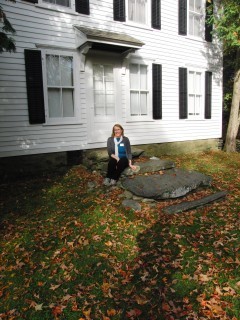
We saw the room where Vincent corresponded and edited. The library is filled with dictionaries, classics, the Bible and the Koran, French murder mysteries, along with images of Shelly, Sappho and Robinson Jeffers. A stenciled sign saying "Silence" hangs from the ceiling, though our docent, Peg, said that Vincent didn't allow others to use the room. (and on the way home, this was one of the statements that got my husband and me wondering about personal history. I mean how do you know no one came in? Was just a sister barred, or did the myth come down from one evening, then generalized as decades passed and memory perhaps did its warping thing? Who knows?)
The garden tour was given by director Peter Bergman, who showed us around the farm where Vincent and her husband grew blueberries, cherries, apples, and wheat, and raised chickens and cows: during WWII, they sold butter to the armed forces. The thirteen "rooms" to the garden mimic the thirteen rooms in the house. Vincent apparently enjoyed eating lunch on a card table among lilies of the valley, even when they were covered with snow. Lupines, irises, and day lilies aren't blooming now, but you could see their stalks along the path to the writing cabin, which was my favorite place.
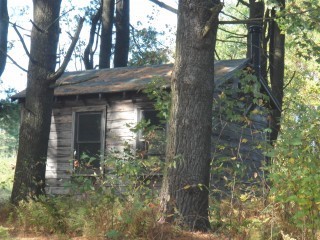
It's austere, with unpainted walls and not much more than a woodstove, a wooden chair and two tables: one to write on, and one with pencil sharpener for snacks. And an alarm clock. Vincent wrote for three and a half hours each day if she had company, and four if she didn't. The cabin was modeled on one she'd seen when visiting George Bernard Shaw in the Cotswalds. (though his was set on a turntable cranked so he'd always get the sun.) Thirty-one pine trees were planted around Vincent's cabin, which her mother had dug up, I think, as saplings, and which Vincent and her sister went to Maine to fetch. Later they added some Maine flowers, so that Vincent could feel as if she were back home as she wrote.
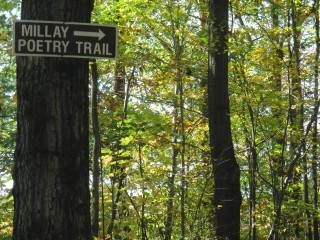
My husband and I walked through the woods to the gravesites of Vincent and her husband, her sister Norma and her husband, and her beloved mother, who raised three girls to think hard and write well, and whose stone is surrounded by mountain laurel. I broke off a stalk from another bush to put on Vincent's grave.
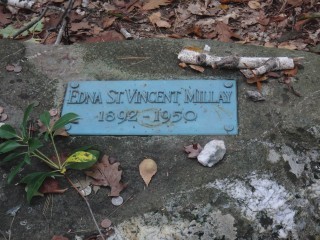
Then I came home and read "Renasence" again, which was written when the poet was nineteen, and won her a scholarship to Vassar. Here are just a few lines from the poem, which I still find wonderful, even if they're better in the six page or so context.
But, sure, the sky is big, I said;
Miles and miles above my head;
So here upon my back I'll lie
And look my fill into the sky.
And so I looked, and, after all,
The sky was not so very tall.
The sky, I said, must somewhere stop,
And – sure enough! – I see the top!
For more Poetry Friday posts, please visit: http://carolwscorner.blogspot.com/2010/10/poetry-friday.html

We saw the room where Vincent corresponded and edited. The library is filled with dictionaries, classics, the Bible and the Koran, French murder mysteries, along with images of Shelly, Sappho and Robinson Jeffers. A stenciled sign saying "Silence" hangs from the ceiling, though our docent, Peg, said that Vincent didn't allow others to use the room. (and on the way home, this was one of the statements that got my husband and me wondering about personal history. I mean how do you know no one came in? Was just a sister barred, or did the myth come down from one evening, then generalized as decades passed and memory perhaps did its warping thing? Who knows?)
The garden tour was given by director Peter Bergman, who showed us around the farm where Vincent and her husband grew blueberries, cherries, apples, and wheat, and raised chickens and cows: during WWII, they sold butter to the armed forces. The thirteen "rooms" to the garden mimic the thirteen rooms in the house. Vincent apparently enjoyed eating lunch on a card table among lilies of the valley, even when they were covered with snow. Lupines, irises, and day lilies aren't blooming now, but you could see their stalks along the path to the writing cabin, which was my favorite place.

It's austere, with unpainted walls and not much more than a woodstove, a wooden chair and two tables: one to write on, and one with pencil sharpener for snacks. And an alarm clock. Vincent wrote for three and a half hours each day if she had company, and four if she didn't. The cabin was modeled on one she'd seen when visiting George Bernard Shaw in the Cotswalds. (though his was set on a turntable cranked so he'd always get the sun.) Thirty-one pine trees were planted around Vincent's cabin, which her mother had dug up, I think, as saplings, and which Vincent and her sister went to Maine to fetch. Later they added some Maine flowers, so that Vincent could feel as if she were back home as she wrote.

My husband and I walked through the woods to the gravesites of Vincent and her husband, her sister Norma and her husband, and her beloved mother, who raised three girls to think hard and write well, and whose stone is surrounded by mountain laurel. I broke off a stalk from another bush to put on Vincent's grave.

Then I came home and read "Renasence" again, which was written when the poet was nineteen, and won her a scholarship to Vassar. Here are just a few lines from the poem, which I still find wonderful, even if they're better in the six page or so context.
But, sure, the sky is big, I said;
Miles and miles above my head;
So here upon my back I'll lie
And look my fill into the sky.
And so I looked, and, after all,
The sky was not so very tall.
The sky, I said, must somewhere stop,
And – sure enough! – I see the top!
For more Poetry Friday posts, please visit: http://carolwscorner.blogspot.com/2010/10/poetry-friday.html
Published on October 08, 2010 04:50
October 5, 2010
KidLit Con and the Cybils Awards
I try to avoid commenting on time's where-did-it-go-to nature, but I was surprised to realize I've been blogging for just over three years. It still seems pretty new. I like the way it sometimes asks me to take an outside look at the inner process, and especially how it lets me be in touch with people around the country. Like my daughter and her old friends Zach and Liz, and her roommate Colleen; with people overseas, like Amy, and someone across the table, like my husband, and people I don't know: thank you for reading! It's also been wonderful getting to know like-minded people online, and I'm very excited to get to meet bloggers and poets like Toby, Laura, Susan, Mary Lee and others at KidLit Con http://kidlitcon2010.blogspot.com/ to be held in Minneapolis later this month. I'm also excited to get to see a lovely person I've known not online, but since she was a baby. Samantha's in her first semester at Macalester College there, and I look forward to seeing a bit of her world.

Bloggers also have their own book awards, and Cybils nominations for beloved books published in the past year can come from anyone until October 15. Click on this link http://www.cybils.com/ for more information Thanks you, Jenny![[info]](https://i.gr-assets.com/images/S/compressed.photo.goodreads.com/hostedimages/1380438177i/889613.gif) jenny_moss
, for nominating Borrowed Names in the Poetry category! I'm still pondering my own nominations, which I tend to do shortly before the deadline, though it means books I wanted to cheer for have already been named and I have to stretch my mind about publication dates. It's fun to read the lists and remember books that bedazzled me or that I meant to read, a reminder to get offline and ruffle some pages.
jenny_moss
, for nominating Borrowed Names in the Poetry category! I'm still pondering my own nominations, which I tend to do shortly before the deadline, though it means books I wanted to cheer for have already been named and I have to stretch my mind about publication dates. It's fun to read the lists and remember books that bedazzled me or that I meant to read, a reminder to get offline and ruffle some pages.
It's going to be a hard-writing week, with a glimpse of an end to a pretty-finished draft in view. Thrilling and nerve-wracking. Will this be it? Did I save the right words?

Bloggers also have their own book awards, and Cybils nominations for beloved books published in the past year can come from anyone until October 15. Click on this link http://www.cybils.com/ for more information Thanks you, Jenny
![[info]](https://i.gr-assets.com/images/S/compressed.photo.goodreads.com/hostedimages/1380438177i/889613.gif) jenny_moss
, for nominating Borrowed Names in the Poetry category! I'm still pondering my own nominations, which I tend to do shortly before the deadline, though it means books I wanted to cheer for have already been named and I have to stretch my mind about publication dates. It's fun to read the lists and remember books that bedazzled me or that I meant to read, a reminder to get offline and ruffle some pages.
jenny_moss
, for nominating Borrowed Names in the Poetry category! I'm still pondering my own nominations, which I tend to do shortly before the deadline, though it means books I wanted to cheer for have already been named and I have to stretch my mind about publication dates. It's fun to read the lists and remember books that bedazzled me or that I meant to read, a reminder to get offline and ruffle some pages. It's going to be a hard-writing week, with a glimpse of an end to a pretty-finished draft in view. Thrilling and nerve-wracking. Will this be it? Did I save the right words?
Published on October 05, 2010 06:03
October 2, 2010
M.C. Escher at the New Britain Museum of American Art
Peter and I recently visited The New Britain Museum of American Art http://www.nbmaa.org/ a treasure not far west of Hartford, Connecticut. Special exhibits included one of Hudson River paintings, illustrations for pulp novels, and the one we especially came for: M.C. Escher: Impossible Reality, showing through November 14. We enjoyed the sketches Maurits Cornelis Escher (1898-1972) worked out on graph paper, and the range of his woodcuts, lithographs, and other prints. Apparently his brother was a geologist, who got him thinking about the symmetry found in crystallized forms. M.C. Escher said he found he usually had more in common with mathematicians than artists. Here is Ascending and Descending:
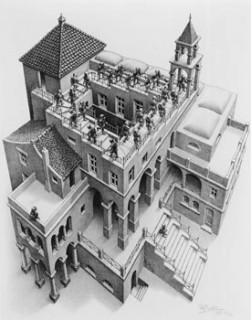
And just an edge of one of my favorites, Metamorphosis, which took up a wall:
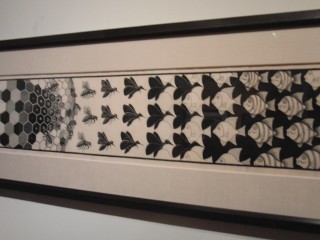
My husband was really the one who wanted to see the show, as Escher's work can leave me dizzy. (It took lots of extra help one summer for me to make it through a college logic course: I had nightmares of tables turning into numbers and letters, and have a thing for solid ground.) But this show tipped me in a good direction, at least for the afternoon.
In 1965 Escher wrote: "I can't help mocking all our unwavering certainties. It is, for example, great fun to deliberately confuse two or three dimensions, the place and space, or to poke fun at gravity. Are you sure that a floor can't also be a ceiling? Are you absolutely certain that you go up when you walk up your staircase? Can you be definite that it's impossible to have your cake and eat it, too?"

And just an edge of one of my favorites, Metamorphosis, which took up a wall:

My husband was really the one who wanted to see the show, as Escher's work can leave me dizzy. (It took lots of extra help one summer for me to make it through a college logic course: I had nightmares of tables turning into numbers and letters, and have a thing for solid ground.) But this show tipped me in a good direction, at least for the afternoon.
In 1965 Escher wrote: "I can't help mocking all our unwavering certainties. It is, for example, great fun to deliberately confuse two or three dimensions, the place and space, or to poke fun at gravity. Are you sure that a floor can't also be a ceiling? Are you absolutely certain that you go up when you walk up your staircase? Can you be definite that it's impossible to have your cake and eat it, too?"
Published on October 02, 2010 08:15
September 28, 2010
Once Upon a Time: Maria Tatar on Fairy Tales and Childhood
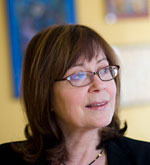
On Saturday I heard Maria Tatar, who chairs the Department of Folklore and Mythology at Harvard College, give a talk at the Eric Carle Museum http://www.carlemuseum.org/Home. She's author most recently of Enchanted Hunters and edited several Norton Critical Editions of tales from Charles Perrault, the brothers Grimm, Hans Christian Anderson (she's a fan and made me one), and others. My children's literature class covers a few hundred years, so we only do a drive-by past fairy tales, but we always look at these. Of course these hefty, heavily footnoted anthologies are intended for adults, so Maria Tatar doesn't try to brush any of the sex and more often violence under the table. But they'd be a valuable resource for parents or other story-tellers. Maria Tatar noted in her talk that "you can't grow up just with facts." She said even incidents in the tales that may seem appalling to us may be made child-friendly by the teller. There's always the lap, and beyond that, tellers may change their voices, raise their eyebrows, act things out to make them humorous, or even add commentary. The tone and setting may be as important as the tale.
Maria gave us a great, swift, and accessible overview of current definitions of fairy tales, with theories on their background and worth, pointing out elements of magic, myth, metaphors, and the migratory nature of the tales. The alliteration is hers. "These stories pass time and they pass along wisdom, making clear what matters in life."
She showed slides, focusing on a picture book of Little Red Riding Hood illustrated by Lisbeth Zwerger, whose exhibition at the Carle just ended. When a librarian in the audience asked for suggestions for parents who balk at checking out fairy tales, Maria noted that about 40% of parents today say they won't read Little Red Riding Hood. She said "children need more than pink princesses and sweet endings," and pointed out that stories keep children curious and benefit parents, too. They may learn, through the child's response, about them, their joys, fears, and needs.
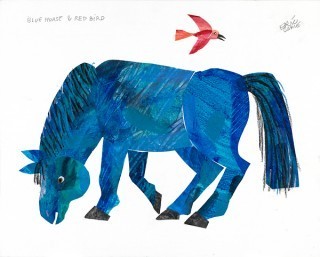
On another note, for those feeling Carle museum love, or want to look at some cool illustrations – and maybe even hang one in your home -- check out the website where you can make a maximum bid on a piece by favorite illustrators like Jerry Pinckney, Grace Lin, Quentin Blake, Raul Colon, of course Eric Carle and about a dozen others. Click on the link below for a look. All proceeds benefit the museum, and bids will be accepted until noon on Thursday, Sept. 30.
http://www.carlemuseum.org/carlehonors/Auction2010.
Published on September 28, 2010 14:55
September 27, 2010
Wonderful Shelburne, Vermont
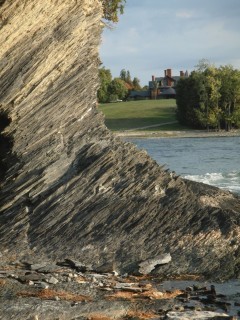
Peter and I walked beside Lake Champlain and stayed at the Shelburne Farms Inn http://www.shelburnefarms.org/ , a family estate from the Gilded Age which was handed down to a generation of five Webb descendents who wanted the buildings and land enjoyed by the public, and where today lots of education in land preservation and local farming is done. And guests at the inn are pampered. Breakfasts were a pleasure: the eggs can't be much fresher, the toast is made with organically grown wheat, and...
Published on September 27, 2010 06:22
September 24, 2010
A Visit to the Robert Frost Stone House Museum
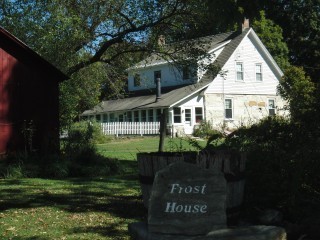
A few days ago my husband and I visited one of the three Robert Frost homes http://www.frostfriends.org open to the public, this one just north of Bennington, Vermont, where the poet is buried. Here's a view of the house though I couldn't fit in the birches, which of all the trees Frost wrote about I think he treated the most tenderly. He said, "I never go down the shoreline to New York without watching the birch trees to see if they live up to what I say about them in my poems."
The walls a...
Published on September 24, 2010 06:37
September 23, 2010
Vermont Love
My husband and I took a few days off to enjoy Vermont, even though it's early for the famous fall foliage. In Manchester, we visited Hildene http:///www.hildene.org where Robert Lincoln, the surviving son of the President and his wife, made his home after earning a fortune in law and business. The mansion, views, and gardens designed like stained glass windows are spectacular.
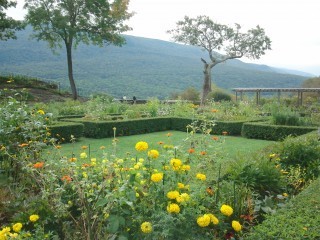
But I might remember this closet most. Above Robert's shoes and suitcases is an open safe which held correspondence ab...

But I might remember this closet most. Above Robert's shoes and suitcases is an open safe which held correspondence ab...
Published on September 23, 2010 15:27
September 16, 2010
Cleve Jones and the Names Memorial Quilt
Last night my husband and I met friends to hear Cleve Jones http://www.clevejones.com/mainmenu.htm speak at UMass-Amherst. Cleve spoke a lot about what it was like to be gay in the 1970s and 80's, a time which is now part of history to students in the audience through the wonderful movie Milk. Cleve got to witness some of the film the making (and joked, "if there's one message I want everyone to take from that movie it's that I used to be hot.") Cleve's talk often moved between humor and tra...
Published on September 16, 2010 07:10
September 14, 2010
Creeping Cautiously Toward an End
Mostly this looks like any other day. I'm still on the porch, but added fleece to my wardrobe. I meddle with a poem I typed, crossing out words and adding some new ones that seem clearer. I draw lines to try phrases in new places. I make big slashes through stanzas, then type the changes on my computer.
But once in a while I get the rush of feeling like I'm a downward slope. I'm sliding toward the end of a revision I'll show to my husband and send to my writing group in the next few days. I'v...
But once in a while I get the rush of feeling like I'm a downward slope. I'm sliding toward the end of a revision I'll show to my husband and send to my writing group in the next few days. I'v...
Published on September 14, 2010 05:51
September 10, 2010
Stumbling into Metaphors
Most of my poems begin with people and the things and places that matter to them. These offer up details that I hope will make readers feel as if they're there, but because every word matters, the details have to do more than evoke a setting. Sometimes they'll create a mood, which I don't have to spell out. Sometimes I'll repeat them through a series of poems to set a pattern, and show what's constant and what changes in a life. In the section of Borrowed Names about Madam C. J. Walker and he...
Published on September 10, 2010 06:34



